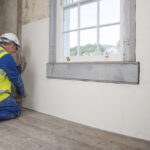Iain Fairnington, Technical Director at A. Proctor Group, looks at the evolution of solid wall solutions.
The issue of how to address thermal insulation in the refurbishment of existing solid wall buildings is a conundrum that leaves many moisture/heat experts discussing at length. Solid walls, usually masonry construction are further defined in BS 5250, Control of Condensation in Buildings, as a wall with no cavity in the load bearing structure. According to the National Energy foundation, 28% of UK properties have solid walls. These buildings will have been built before 1919. This provides a good opportunity to not only save money by improving the insulation, but also deliver CO2 savings.
In the last 100 years the solid wall has been replaced with cavity walls when building masonry, but why? Solid masonry walls were relatively easy to build using locally sourced stone that provided structure to support a roof. The difficulty with the solid wall was that in areas of high exposure, in the North and West of the UK, water ingress was found due to driving rain. Thicker walls and even render did not solve this issue until the cavity wall was introduced. The cavity prevented the wall ‘seeping’ moisture from the outside to the inside, and this same air cavity also provided a degree of thermal benefit compared to its former solid predecessor.
The cavity wall was then adopted throughout the UK in the building booms of the 1920s, 30s and 40s. With the later oil crisis putting a strain on energy efficiency, these cavities became the ‘easy to treat’ thermal upgrade measure we see today, with the innovation of a range of suitable insulation materials and methods of application.
Unfortunately, the solid masonry wall is not as easy to treat and has been labelled as a HTT (Hard to Treat) construction in terms of thermal upgrades. There are no cavities that can be easily filled with insulation and the owner is therefore left with only two options — insulate externally or internally.
EWI (External Wall Insulation) can be a very efficient way of insulating a property. By insulating externally, the buildings water tightness is improved, as well as its thermal value, and the thermal mass retained. However, this can detract from the original intended aesthetics of the building and could fall foul of local planning conditions. This then leaves the only other thermal upgrade involved, which is IWI (Internal wall insulation).
HAMM principles
Depending on your mindset, solid wall properties can be a challenging proposition. Many moisture experts agree that the best way to keep a building healthy is to put the heating up and open the windows. However this raises valid concerns in terms of the issues of climate change, energy efficiency and fuel poverty. So, what is the answer?
There are answers to IWI but the options must be carefully weighed up, and with the current Green Homes Grant the options increase and costs can be offset. However, before deciding on the thermal improvements to solid wall properties specifiers should first consider the HAMM (Heat Air Moisture Movement) principles of good moisture control.
It is important to assess the wall condition and whether it is allowing water ingress to the property, as improving the thermal performance may accelerate the deterioration of the building envelope. High performance rigid insulations can be seen as an obvious choice for retrofitting solid walls internally as they will improve the reduction in heat loss. However, this high-performance insulation usually comes with increased vapour resistance, which can be an advantage in some cases, but not necessarily in a solid wall.
A solid wall may have been successful in resisting water penetration to the inside due to its breathability or to put more accurately its vapour permeability. With its inherent vapour permeability, the wall can dry out faster than the wall can be wetted, hence maintaining the relative dryness equilibrium. Once a low permeability insulation is applied internally, the solid wall loses an additional drying out mechanism through heat loss, as well as losing its inherent vapour permeability. Remember these walls were designed to absorb and release moisture internally and externally to maintain the moisture balance, which could become increasingly important as periods of wind and rain continue to increase due to climate change.

Thermal performance
Mineral and cellulose fibre can improve the thermal performance and help maintain the vapour permeability, but are at a much thicker option which most old buildings cannot accommodate.
The A. Proctor Group has been providing IWI solutions for many years, some as far back as the original plasterboard laminate of Styrofoam, Plusboard. Many of these systems have evolved over time culminating in the Aerogel laminates called Spacetherm laminates including its new Spacetherm A2 range. This aerogel insulation is a high-performance insulation, which has low thermal conductivity without compromising the vapour permeability. This dual performance is enhanced by its inherent water resistance, which makes it the ideal solution in solid walls to fix directly against potentially damp walls. This does not mean the insulation completely stops water penetration, and good practice with any wall should be assessed before IWI is installed and measures taken to fix areas of water ingress.
In areas where other insulations are used such as mineral fibre, the inclusion of an intelligent vapour control layer can help with moisture controlling measures. Procheck Adapt is a variable membrane within the A. Proctor Group’s range of vapour control layers, which allows the membrane to open and close its vapour permeability depending on the climate. In the summer it allows the wall to dry out, whilst in winter it closes to prevent vapour passing into the envelope.
The A. Proctor Group is extremely experienced and skilled in HAMM principles, with a strong technical department to advise on the options.









